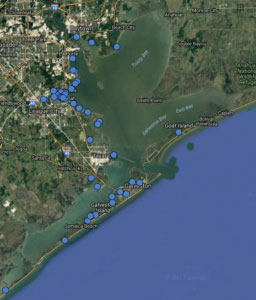GALVESTON BAY FOUNDATION REPORT

Overall, results from Galveston Bay Foundation’s volunteer water quality monitors were positive this past year. The water monitors collected 444 water quality samples at 51 sites around Galveston Bay.

Volunteers tested for air and water temperature, dissolved oxygen, pH, salinity, water transparency, depth and at some sites, fecal indicator bacteria.
Dissolved oxygen levels, which indicate suitability for aquatic life, remained at healthy levels throughout the Bay; only one percent of the samples collected too low to support life. Water transparency and pH remained stable and relatively unchanged to past years.
The data also found fecal indicator bacteria levels safe overall within Galveston Bay, with 90 percent of the samples collected safe for swimming and boating. Many samples with unsafe bacteria levels were collected after major rain events.

Stan Conley, a Galveston Bay Foundation volunteer water monitor found unusual results after a waterspout moved over the marina he monitors at on Offatts Bayou in Galveston. He learned how significant weather events, no matter how short the duration, have an impact on water quality.
“Being aware of subtle changes in the area and how that is reflected in water sampling results is now a topic of discussion with my friends both personal and business alike,” Conley said. “I am very proud to be a very small part of Galveston Bay Foundation’s efforts.”
Additionally, salinity levels were one slightly concerning indicator and reported slightly lower than normal throughout much of Galveston Bay. Over time, these lower salinities can impact plant and animal life. For example, this summer’s low salinity levels are thought to have limited oyster spawning within the Bay.
Both air and water temperatures were also slightly higher than in past years. Through continued, long-term monitoring of water quality, Galveston Bay Foundation will better be able to understand whether this is a significant trend.
To view the 2016 water quality results or to get involved as a water monitor, visit www.galvbay.org/watermonitor today.
